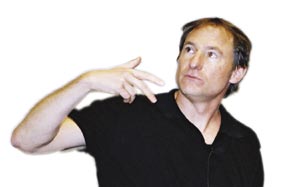 Matthew Fisher, KITP permanent member
Matthew Fisher, KITP permanent member
“Our intuition is all about particles and positions; it is not about quantum waves,” said solid-state theorist Matthew Fisher, a permanent member of the Kavli Institute for Theoretical Physics at UC Santa Barbara. “We don’t have good experimental probes that measure particle waves very well. We’re good at measuring particle positions, but not the phase of waves because we ourselves are solid, and solids by nature are good at measuring the positions of things."
“What makes it so difficult for people to grasp quantum mechanics is the necessity of thinking in terms of both particles and waves at the same time — the wave/particle duality."
“If liquid helium atoms are cooled under pressure, they crystallize,” he said. “In a crystal, the atoms are basically behaving classically; there is some quantum motion, but more or less the atoms stay still like an atom in a solid should. But reduce the pressure a little bit, and the atoms go into a liquid, into a Bose/Einstein condensate or superfluid. Suddenly the atoms are behaving very much like waves, but the waves are kind of classical because all of the atoms are ‘waving’ coherently like photons in a laser."
“What’s really interesting are situations when large collections of quantum mechanical degrees of freedom [lots of variables such as position, spin, and charge] are behaving in a manner which is not easy to understand in terms of either a particle or a wave picture. Both types of behavior are simultaneously manifest."
“Gaining intuition for those intrinsically quantum mechanical choreographies, in which neither wave-like nor particle-like aspects are dominating, requires thinking about both together. You really want to be thinking somehow ‘in between’ the two pictures.”
Fisher won the prestigious Waterman Award in 1995, for demonstrating, according to the specifications for nomination of candidates, “exceptional individual achievement in scientific or engineering research of sufficient quality to place them at the forefront of their peers.”
Fisher said he learned to think quantum mechanically by thinking mathematically first.
“One’s intuition can with time transcend the mathematics. I would say that mathematics is to physics, what grammar and syntax are to poetry. You can’t do the latter well unless you have a deep grasp of the former. You can’t compose poetry without language, and once you know a language, it affects how you think. When you are thinking in images, you may be operating in a mixed mode somewhere between words and vision. One’s thinking is so intertwined with one’s knowledge of language that, having done enough mathematics, it’s hard to know what is physical intuition and what is mathematical because you now have an intuition for mathematics.”
So physics may not just be a game for the 20 and 30 somethings, like so many of the prized behaviors of society, such as athletics and TV script writing?
“Twenty is, I think, too young, for great physics,” said Fisher. “At the other end, obviously, one eventually burns out. I do notice that the leaders in string theory are not only 30-year-olds, but also 40- and 50-year-olds. With the 50- and 60-year-olds who were great successes earlier on, their success tends to generate distractions in the form of new duties. And physics, above all else, takes incredible focus.”
